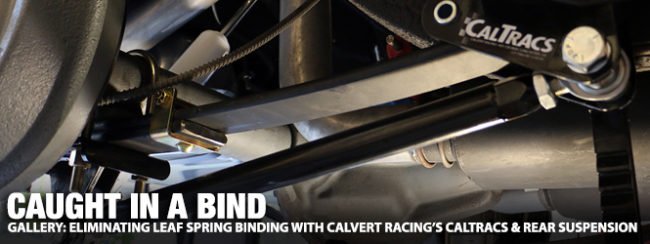
Imagine you’re patiently waiting at a stop light at a quiet intersection. The lope of your Mopar’s idle thrumming along as you wait for the light to change. Rolling up beside you is some kid in a late model Mustang. He gives your classic a once over and wrings off a high pitched, almost-nasal rev, motioning that he’d like to race. While you’re not in the mood for a ticket, you see no harm in blowing his doors off for the first 60-feet or so. Two-footing the pedals, you spool up the torque converter and feel the rear suspension begin to load. Your wits are keen and BAM! you’re on the throttle the second the light changes, but as you mash the gas you feel your back tires break loose, barking intermittently as they sporadically lose grip. Off goes the Mustang through the intersection…
So what happened? The kinematics of your classic Mopar’s factory-stock leaf spring rear suspension have robbed you precious traction, that’s what. Kinematics is often referred to as the “geometry of motion” and directly refers to “the motion of points, bodies (objects), and systems of bodies (groups of objects) without considering the mass of each or the forces that caused the motion.” While that might fly over the heads of most, kinematics – in relation to traditional A, B, C and E-body parallel rear leaf spring suspension – is supremely important when considering how torsional force (ie. “energy”) is distributed, applied and consequently, lost.
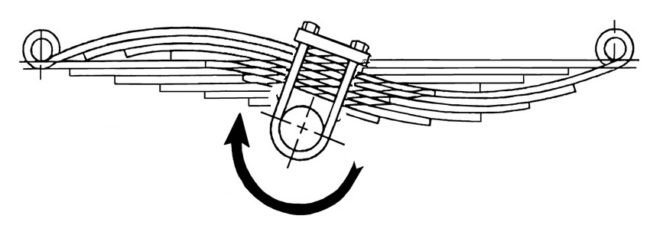
Above: This is an illustration of axle wrap or “binding.” This phenomenon occurs as rotational force transfers through the differential’s pinion, through the axles, and to the tires. A confluence of factors (such as spring rate, quantity of spring bars, durability of rubber bushings, pinion angle, tire grip/road surface) can lead to axle wrap and can cause wheel hop, all of which scrubs traction.
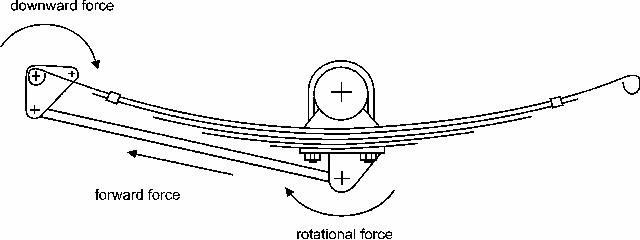
Above: Although several innovations have been made to thwart axle wrap and wheel hop (such as pinion snubbers, leaf and axle wedges, and traction or “slapper” bars, etc.) the most successful addition to a leaf spring suspension has been the cantilever-type traction bar, mainly popularized by Calvert Racing’s renowned CalTrac rear suspension system. The under-axle pivot uses rotational force to activate a cantilever backwards, applying downward force on the front of the leaf spring, thereby circulating the rotational energy back into the leaf spring in a controlled circuit.
Parallel leaf spring suspension dates back to Conestoga wagons, and was first applied to automobiles by American-born inventor Benjamin Berkley Hotchkiss (no relation to today’s Hotchkiss Sport Suspension) back in the late 1800’s. In Mark Savitske’s brilliantly researched technical guide book, How to Make Your Muscle Car Handle, he explains that “because [the leaf springs] are being called upon to perform numerous different functions, this suspension’s kinematics are actually very complex. [The leaf springs] longitudinally and laterally locate the axle, control pinion angle, […] locate the instant center, define the roll steer characteristics, anti-squat, and roll center, and of course, hold the weight of the car at its desired ride height, all at the same time.”
This means that while accelerating from a dead stop, the rotational forces placed upon those flat bars of sprung steel are being twisted, pulled and pushed in several different directions and in differing strengths simultaneously. When under load, rotational force (ie. “torque”) will seek out the fastest route to deflect energy; and it is the goal to to ensure that all of that force is directed and applied to keeping those rear tires hooked up. Naturally, the spring will try to combat the opposing force but can only do so by disengaging from the source of torque and break the free from traction.
Above left: Not only did we elect to improve our rear suspension’s hook-up by ordering a pair of CalTrac traction bars, but we also received a pair of Calvert Racing’s Split-Mono Leaf rear springs. Calvert also supplied all new U-bolts, hardware and bearing grease. Above right: Because CalTrac bars allow for the setting of pre-load adjustments, we also picked up a pair of their AN-style billet wrenches. These allowed us to manually adjust the CalTracs for cruising, or at the drag strip.
This violent loss of traction is a byproduct of spring wrap, a phenomenon wherein the front half of the spring bends enough to bind the rear half, contorting the spring into a wave-like S-shape. This wave is caused by torque transferring from the tires forward through the spring, virtually convexing the forward half of the leaf and pinching the latter half. When torque is transferred to the tires and begins to contort the leaf springs, the pinion attempts to rotate upward towards the undercarriage. It is here where the arithmetic of energy redistribution plays a key role in whether your Mopar’s rear suspension will keep you “hooked up” or will have you “breaking loose.”
The first law of thermodynamics (also known as Law of Conservation of Energy) states that energy can neither be created nor destroyed; or that energy can only be transferred or changed from one form to another. Savitske notes that when at a standstill (or “static”) the pinion angle remains neutral. Yet, when the brunt of rotational force from the driveshaft is applied to the differential’s pinion, the torque (or “energy”) looks for routes to redistribute, naturally finding the weakest (or less rigid) links. Depending upon the application, this might be as deflection through soft rubber bushings, the wrapping or binding the leaf springs, or optimally, through rotating the tires as they bite into the asphalt.
Above left: Many eagle-eyed readers of Mopar Connection will have noticed that prior to today, we ran Competition Engineering’s “Slide-a-Link” system prior to installing the CalTrac bars. Although somewhat similar in appearance, their function is not identical, as the Slide-a-Links have a split (2-piece) traction bar with a large Delrin bushing in the middle. This bushing absorbed a great deal of rotational force, rather than redirecting said energy through the front cantilever and back into the spring. Above right: For fun, we fully assembled our Calvert springs and CalTrac bars and weighed it against our Mopar Super Stock springs and Slide-a-Links; the difference was a staggering 28-pounds.
For the layman, the “quick fix” would be to adjust the pinion angle slightly downward. To do so with leaf springs would either require some effort to grind off the the mounting pads from the housing and manually reposition and welded back on, or insert a wedge-shaped spacer block between the spring and the housing perches. Although effective, other less intrusive options have been developed:in the mid-1960’s Chrysler developed special leaf spring packs called “Super Stock” springs. Well over a decade ago, we scored a nice set of Mopar Performance Super Stock springs for our long-term ’69 Dodge Charger R/T project car, which worked nicely until we severely ramped up the Charger’s torque output.
Designed specifically for those racing in Super Stock classes, Chrysler engineered the main leaf with a heavier rating, an extra support clamp and with an extra sixth leaf. In fact, adding additional leaves to stock spring packs was a common practice until it was outlawed by several racing bodies. As a “work around” to the ruling, racers clamped the leaf springs from the axle housing forward, as clamping the individual leaves forward of the axle increases rear roll stiffness while retaining enough flexibility in the rear to handle corners. Often called the “Moonshiner’s Trick,” it dates back to the original Hudson Hornet from the early 1950’s.
Above left: Calvert’s Split-Mono Leaf springs come with an aluminum bushing already pressed in. The cantilever pivot bracket comes mainly pre-assembled, requiring only the roll pin to hold it to the front spring perch. Above right: The roll pin needs to be greased before being inserted through the front spring bushing.
Other innovations were developed over the years, including wedging the rear of leaves, which dramatically improves traction and handling stability in corners (a modification that ultimately disqualified Glenn Dunnaway’s win at the first-ever NASCAR race in 1949). A final trick developed by early drag racers proved so successful that auto manufacturers began including it on factory-built cars: pinion snubbers. Today, adjustable pinion snubbers are some of the most common additions to leaf spring-equipped racers. As our particular Dana 60 did not come with the cast-in pinion snubber mount, we had to explore more scientific routes.
Today, leaf springs typically come in two varieties: mono and multi-leaf. As the name connotes, the mono-leaf is comprised of a single (or split) tempered steel or composite spring bar hung between a forward eyelet and a rear shackle (or slide); multi-leaf springs are a stack of several springs of different lengths and thicknesses hung in a similar fashion. In a previous article by this author, he states, “The key to the leaf spring’s success […] is in its wide spring base design. The wider apart the springs are mounted, the fewer body roll tendencies appear. Moreover, car designers found conditions like heavy bumps or holes that would cause considerable rear steer with four-link or coil-over setup cars were no problem for those with leaf suspensions.”
Above left: We also applied a little bit of grease to the flat outside surfaces of the aluminum eye bushing before installing the cantilever pivot bracket. Above right: We strongly recommend removing the front spring perch (it’s easier this way) so that it can be bolted together before bolting back into the car.
So while the advantage of a rear leaf suspension becomes evident as they perform several functions that other suspension setups would need additional equipment to do – such as controlling chassis roll, lateral forces (similar to how a panhard bar does), and better regulates deceleration forces – there are some noteworthy shortcomings (ie. axle wrap) to circumvent. For our ’69 Dodge Charger, the solutions came quickly. One phone call to Calvert Racing in Lancaster, CA, was all we needed. Calvert’s Eric Oats was quick to point out: “[Calvert’s] Split-Mono Leaf springs substantially lighter than your multi-leaf springs and will save you some major [unsprung] weight.”
Calvert has dedicated years to developing its adjustable split-mono leaf spring, and have become the go-to for drag racers across the nation, earning Calvert 6 of the last 7 World Champions in Stock Eliminator class. The Calvert springs come with pressed-in aluminum bushings in the front eyes to eliminate deflection otherwise common to rubber front bushings. Likewise, new heavy-duty urethane bushings come in the rear eyes with heavy duty alignment spring clamps holding the two halves together. Calvert also offers its split-mono leafs in stock or other height configurations. For Brazen, we opted for the 1-inch drop, as we had been running a similar lowering block (because of our 29-inch tall Hoosier 29” x 11.5 x 15” Quick Time Pro slicks) until now.
Above left: With the differential housing lifted, it’s easiest to slide the front hangar back into place. Even with a pair of torque boxes welded at the sub-frame joints, access to tighten down the four nuts is no problem. Above center: Our previous rear shackles had extra-thick polyurethane bushings that set the shackles too far apart. Although the Calvert Racing Split-Mono Leaf Springs can be used with stock shackles, we replaced ours with Calvert’s own rear shackle kit. These comes with a 9/16″ shouldered bolt that necks down to a 3/8″ thread, with the required nuts and polyurethane bushings. Above right: Calvert Racing’s CR Series 9-Way Adjustable Shocks feature a single knob that allows for easy on-the-fly adjustment, with 1 being softest, and 9 being the firmest.
And while Calvert does offer wedges and spacers to manually manipulate the axle’s pinion angle, the single-most innovative product that they offer are Calvert Racing’s CalTrac bars. For nearly 20 years, Calvert Racing’s leaf spring cantilever-style traction bar system is the single-most successful anti-wrap, traction-enhancement kit on the market today. Whether used with Calvert’s split mono-leaf springs or factory-style leaf packs, the CalTrac system is 100-percent non-invasive, completely bolt-in and requires zero cutting, welding or modification (meaning it’s entirely reversible if/when the situation requires). Moreover, each kit comes freshly powder-coated in gloss black, and requires little more than a couple of hours’ worth of time to install.
Savitske details the cantilever-style traction bar system as “the more sophisticated link-type traction bar.” In describing how it (being the CalTrac bar) operates, he details: “The link pivots on both ends, but […] the front mount pivots on the front spring bolt and has a cross pin that bears down on the top of the front half of the leaf spring to counter wrap-up. The geometry of these bars is much better than the under riders [ie. “slapper bars”] and they can be very effective.” The rigid bar running from beneath the axle perch to the front eye of the spring acts as a lever against the rotational forces trying to distort the front of the spring. This, in turn, keeps axle from rotating, helping maintain pinion angle. And as the bar is fully adjustable, preload can be set by wrenching the bar (using Calvert’s own AN-style wrenches) tight or loose for maximum traction.
Above left: With a bit of pressure from the floor jack, compress the suspension to attach the transfer link, making sure to coat the rod ends with grease. Then, begin threading the transfer link by hand until the rear rod end lines up with the lower mounting point. Calvert instructs to “tighten the rear mount bolt and set a slight air gap between the roll pin and spring’s upper surface.” Above right: With our new Calvert Racing suspension and CalTrac traction bars installed, we’re ready to set the car back on its tires and take her for a spin.
Oats noted, “[CarTracs] can be used on anything from a daily driven car to an 8-second outlaw race car.” And CalTracs have been approved for use by PSCA, NMCA, NHRA. Moreover, Calvert Racing painstakingly developed a full-color, highly detailed installation guide, which comes with your purchase of any set of CalTracs. Included is all the hardware, lubricant and parts necessary to make the swap as effortless as possible. Because of our neurotic need to be thorough, we also opted for a pair of Calvert’s CR Series 9-way Adjustable Rear Shocks. Interestingly, these rear shocks were formally known as Rancho, before being bought out and are now officially a Calvert Brand. We also opted for a pair of B/E Body Rear Shackles with polyurethane bushings. Again, the installation is surprisingly easy, requires little in the way of expertise know-how and will immediately improve the ride and traction of your mighty Mopar.
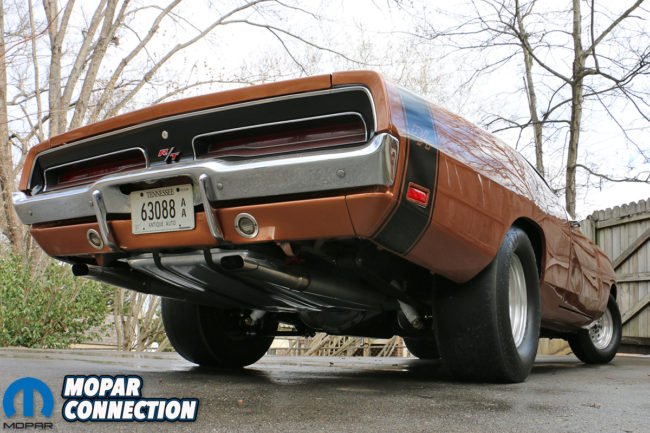
Above: Although temperatures were too cold for a proper testing, we did romp on the gas to let the tires burn off a few hundred miles’ worth of rubber. We’re excited to properly test out our new suspension at the track with the slicks aired-down, and the track prepped for a nice hard launch. Stay tuned!



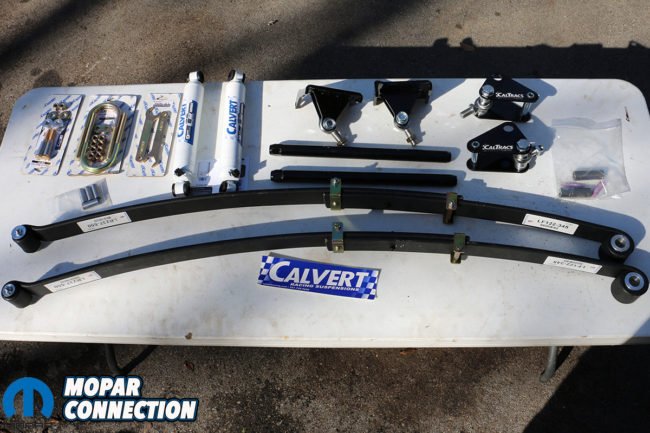
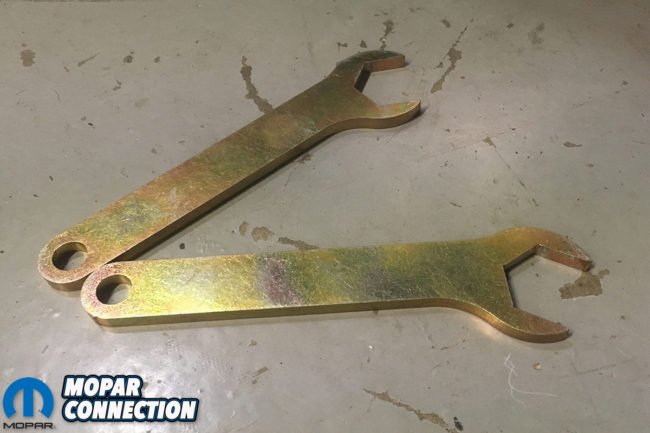
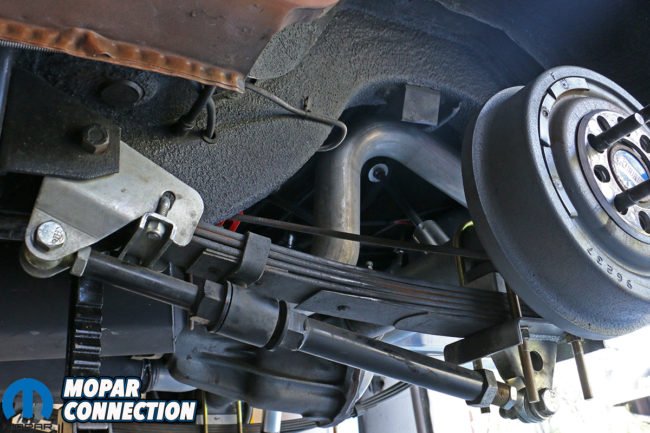
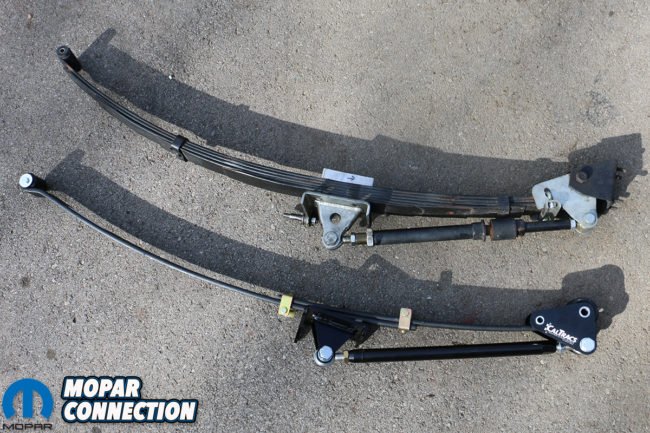
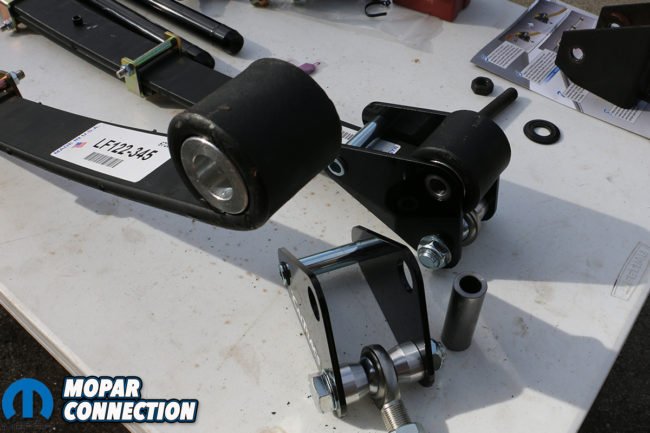
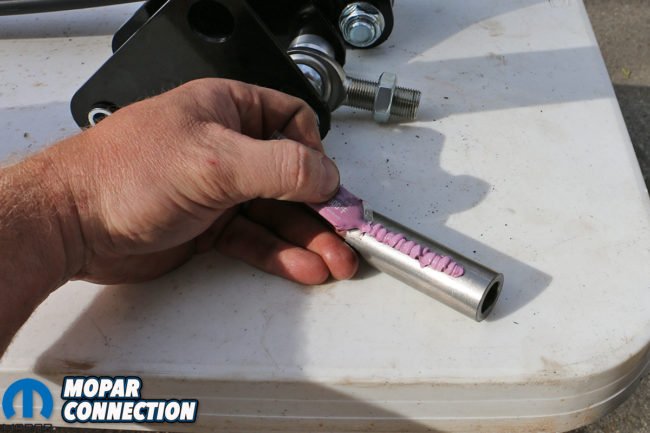
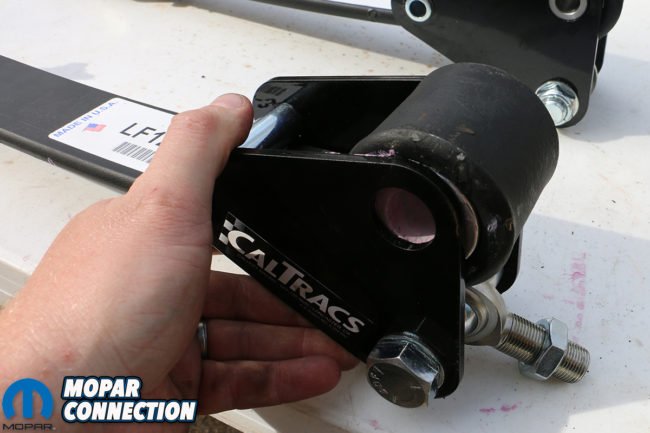
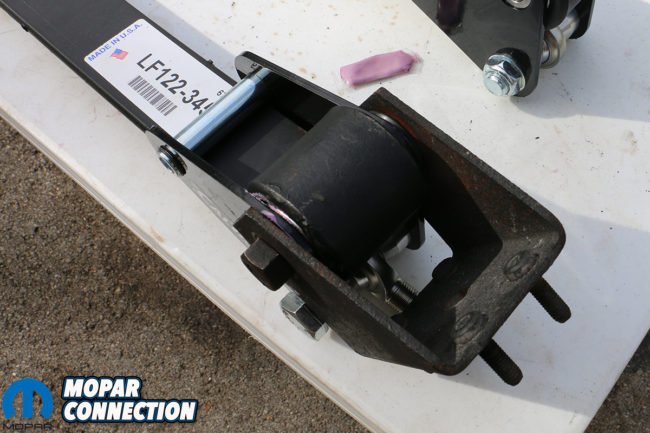
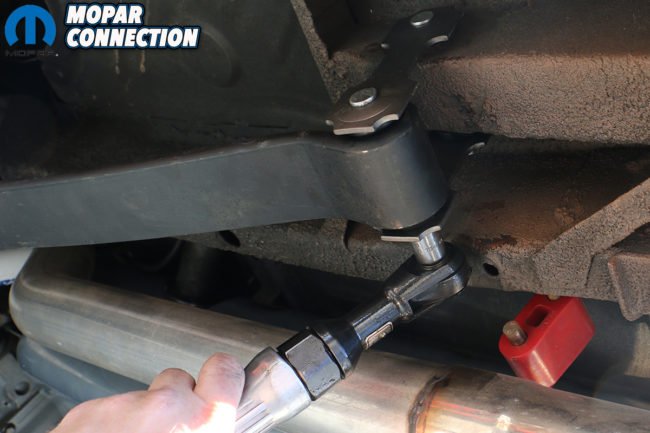
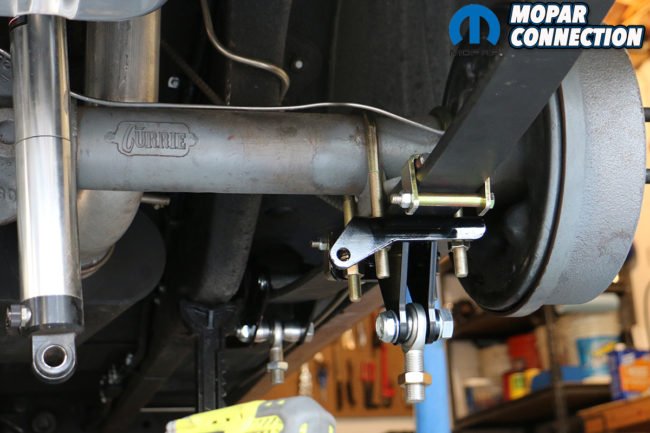

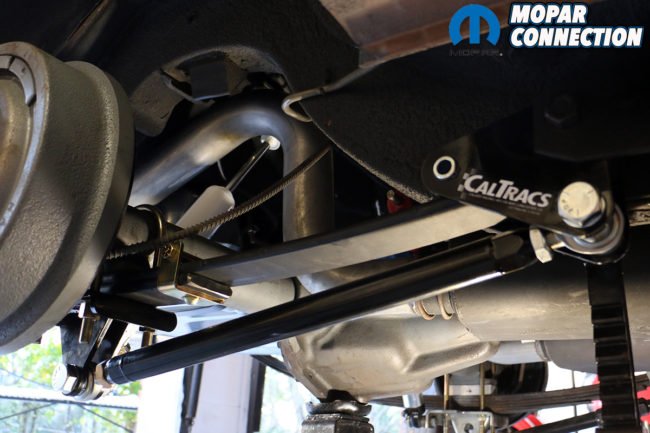
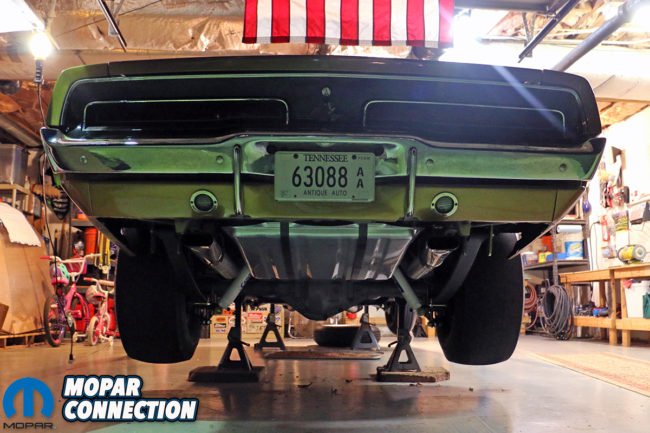

















FYI. Calvert did not buy out Rancho, he just copied them. Rancho still makes their adjustable shocks, They just don’t market them for cars, just trucks/suvs
Hey guys,,
I have a 1969 Sport Fury 838 aluminum Heads roller cam,, 530HP at the wheels, 3.73 gear Detroit locker,
looks some Hook Help,,, C Body springs are 2in longer that B Body, from the axle to the rear hanger,
would like to use the Calvert springs, if not the stock springs are only 2 years old,,
will the Calvert springs raise the back of the car,?? I would like to lower the car 1 to 2 in,, front and rear,
price the caltracks system for me,, with springs,
They have lowering springs and shackle kits; we went from factory Hemi springs to Calvert’s 1″ drop springs on our Charger. Just get on the phone and tell them your setup and what you’re looking for.